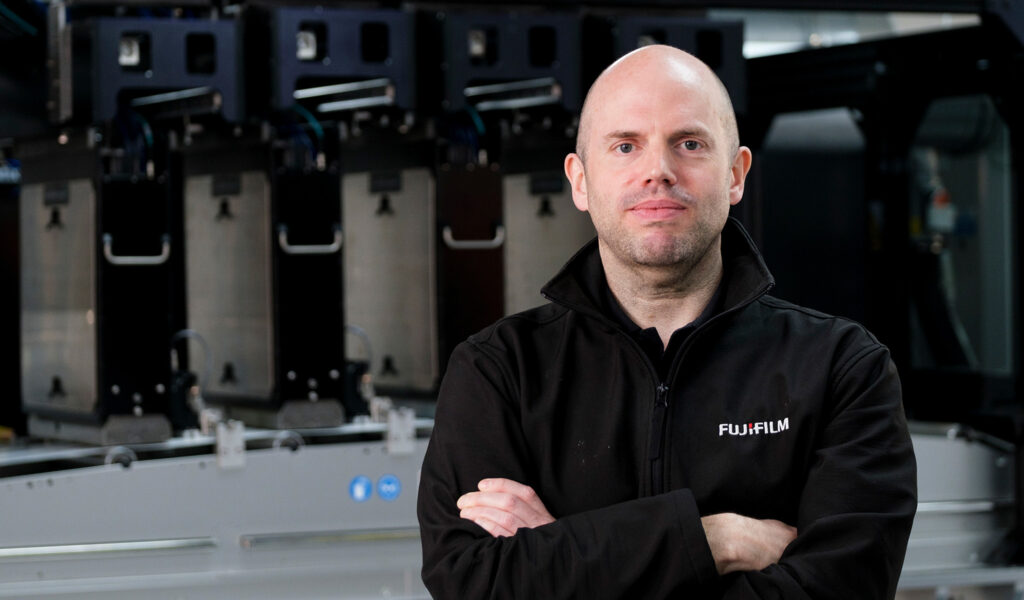As application support specialist Mark Harvey explains, our application development team gives customers a workable inkjet solution that’s printable and compatible with the printhead, ink system and end-use application.
“We’re always looking at how we can get to the endpoint of a project quickly without missing anything. It’s trying to be as efficient as possible to meet customer deadlines. As soon as the ink is ready, we’ll try and test it”, Mark Harvey, Application Support Specialist

The sooner a customer involves the Applications Development Team, the better because the ink, the printhead and the hardware that delivers the ink to the printhead (the ink system) must all work together and be compatible. If something is not entirely set up right or there’s a weak link, it can cause problems.
When the machine is still on the drawing board, we can influence what printhead to use and suggest how much drying capacity to build in and the suitable maintenance systems to take some pressure off the ink. However, when a machine is built already, the ink must do its job while working within the constraints hardwired into the system. The ink formulation might have to compensate for insufficient drying or a complex maintenance system.
Broad experience and teamwork
Within the team, I support original equipment manufacturer (OEM) trials and projects in UV curing and aqueous digital inks. My role is specifying the ink and filling in the blanks about why doing certain things for a specific application or requirement may not be a good idea.
At Fujifilm, we offer a total solution system with ink system integration and printheads. Our Group provides inkjet inks and pigment dispersions to OEM customers. Other Fujifilm divisions develop printers. Our access to people with experience using either another manufacturer’s machines or ours means we have seen every problem within our business units and can help customers.
We have the R&D team available on-site and when we’re working on a UV project, we have the resources to help. There is an analytical department where we can work through a lot of testing and an integration engineering facility in Cambridge, UK. If we’re looking at printheads or ink systems, weget them involved. Then, we have many resources in Japan, including the world-class Advanced Marketing Research Laboratory.
Confidentiality is strictly preserved within each project
Customers often tell us, “We’ll show you this, but you can’t tell anyone else,” and if those are the conditions, we work to them. We build trust with the customer, and we do not offer that information to other parties.
On a practical level, sometimes there are conditions they may not have specified, and I interpret them to create a workable solution. For instance, you can’t put a number on open time and drying speed – you must guide the development groups to hit a point that allows them to dry fast, but not so fast that you can’t handle it in the printhead.
There are a lot of test printers or jetting rigs, and we can either test ourselves or find a way of replicating the printer environment and the application space – the job it must do in the end. If we can’t do that internally, we can often find a partner to work with.
Putting the inkjet ink through its paces
Customers want the ink to be compatible with the end-use application: whether it’s an industrial product that must be light-fast, or indirect food packaging that must conform to regulations. It’s about compatibility from the start to the end of the ink’s life, which could be 10 years in some applications. We’ll assemble all the components and give it the testing it must have in the end-use to ensure the inkjet ink is correct.
With UV ink, the biggest issue usually is aligning the ink’s cure speed with the press’s cure capacity. There will be several UV lamps (LED or mercury, depending on the print speed), and the ink must be reactive at a certain level. If it’s too reactive, it will cure too quickly on the nozzle plate and cause issues within the printhead. On the other hand, if it doesn’t cure quickly enough, you won’t reach the production speed you want.
On the aqueous side, drying is the issue. The industry has several different drying techniques available. Some are better for certain applications than others. We look at these and see which ones we think would be beneficial. This type of work will be done in Japan, as they have extensive experience and big machines for testing.
Attention to detail
The ink is the colorful part you see on the end product, so it’s actively sold. But what about the cleaning solution? It’s easy to get a good print from the printer on day one. The actual task is getting a good print from it 6-12 months to 2 years down the line. That’s why I’m always harping on about the need to develop the cleaning and maintenance system and fluids with as much energy and dedication as we do the inks. It’s all a combined system, and only as good as its weakest link.